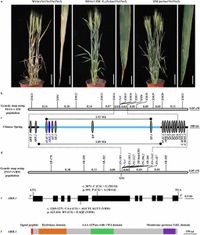In a groundbreaking study, researchers have successfully identified the elusive Ne1 gene in wheat, a discovery that enhances our understanding of hybrid necrosis—a complex genetic incompatibility that can severely hinder wheat breeding. Hybrid necrosis, characterized by symptoms such as leaf crinkling and stunted plant growth, occurs due to epistatic interactions between diverging alleles from different parent strains, leading to autoimmune-like responses in the plants.
The critical breakthrough came as researchers worked with the Ne1 and Ne2 genes, which are known to induce hybrid necrosis in wheat, particularly in cases where both are present together. "Ne1, which encodes an alpha/beta hydrolase, triggers hybrid necrosis with Ne2 by activating autoimmune responses," wrote the authors of the article, explaining how this interaction complicates breeding practices aimed at enhancing wheat traits.
A team from the Institute of Genetics and Developmental Biology at the Chinese Academy of Sciences conducted this study with extensive plant material sourced globally. The research incorporated advanced techniques such as map-based cloning, mutagenesis, and transgenic assays to demonstrate how Ne1 works alongside Ne2. This research is essential, as hybrid necrosis can impose significant barriers in improving wheat varieties by restricting the integration of beneficial traits.
While Ne2 is frequently selected for its resistance to rust diseases in wheat breeding, the implications of Ne1 have historically been overlooked due to its association with hybrid necrosis. The study found that the Ne1 gene likely originated from wild emmer wheat, suggesting it underwent segmental duplication and ectopic recombination in its evolutionary history. Understanding its expression dynamics in relation to Ne2 provides a clearer picture of hybrid necrosis variability. Additionally, the research highlighted the role of allelic and copy number variations of the Ne1 gene in the phenotypic diversity of hybrid necrosis observed across wheat cultivars.
Hybrid necrosis has consistently posed challenges, with its effects first noted over a century ago. It's linked closely to plant immune responses, with a myriad of causal genes having been previously identified. This ancient phenomenon of genetic incompatibility has implications for gene flow barriers between hybrid plant species and must be addressed in modern breeding programs.
Utilizing a comprehensive genomic approach, the researchers constructed fine genetic maps for the Ne1 gene through two different populations derived from hybrids, confirming that structural variations include copy number variations (CNVs) that influence how Ne1 expresses itself. "Our findings illuminate the co-evolution of the NLR/ABH gene pair in plant development and innate immunity," wrote the authors, pointing to the broader implications of these discoveries for the agricultural sector.
The Ne1 and Ne2 genes collectively embody the complexities of plant genetics. With modern wheat cultivars exhibiting progressively reduced prevalence of the Ne1 gene, understanding its function and benefits could help farmers and breeders develop new strategies that enhance crop resilience while also avoiding the negative impacts of hybrid necrosis.
In Japan, for example, wheat varieties employed in breeding programs have often contained Ne2 due to its selective advantages against rust diseases, inadvertently leading to the decline of Ne1’s presence. This study shows the ABCs of autoimmunity in plant species and explores fertile territories for further research and potential applications.
As researchers delve deeper into understanding the genetic intricacies of hybrid necrosis, the implications are clear: addressing the genetic incompatibilities in wheat could play a pivotal role in increasing a crop’s resilience and productivity. This study not only strengthens the scientific foundation surrounding wheat hybrid necrosis but also opens up critical pathways for future research into improving wheat cultivation practices globally.

